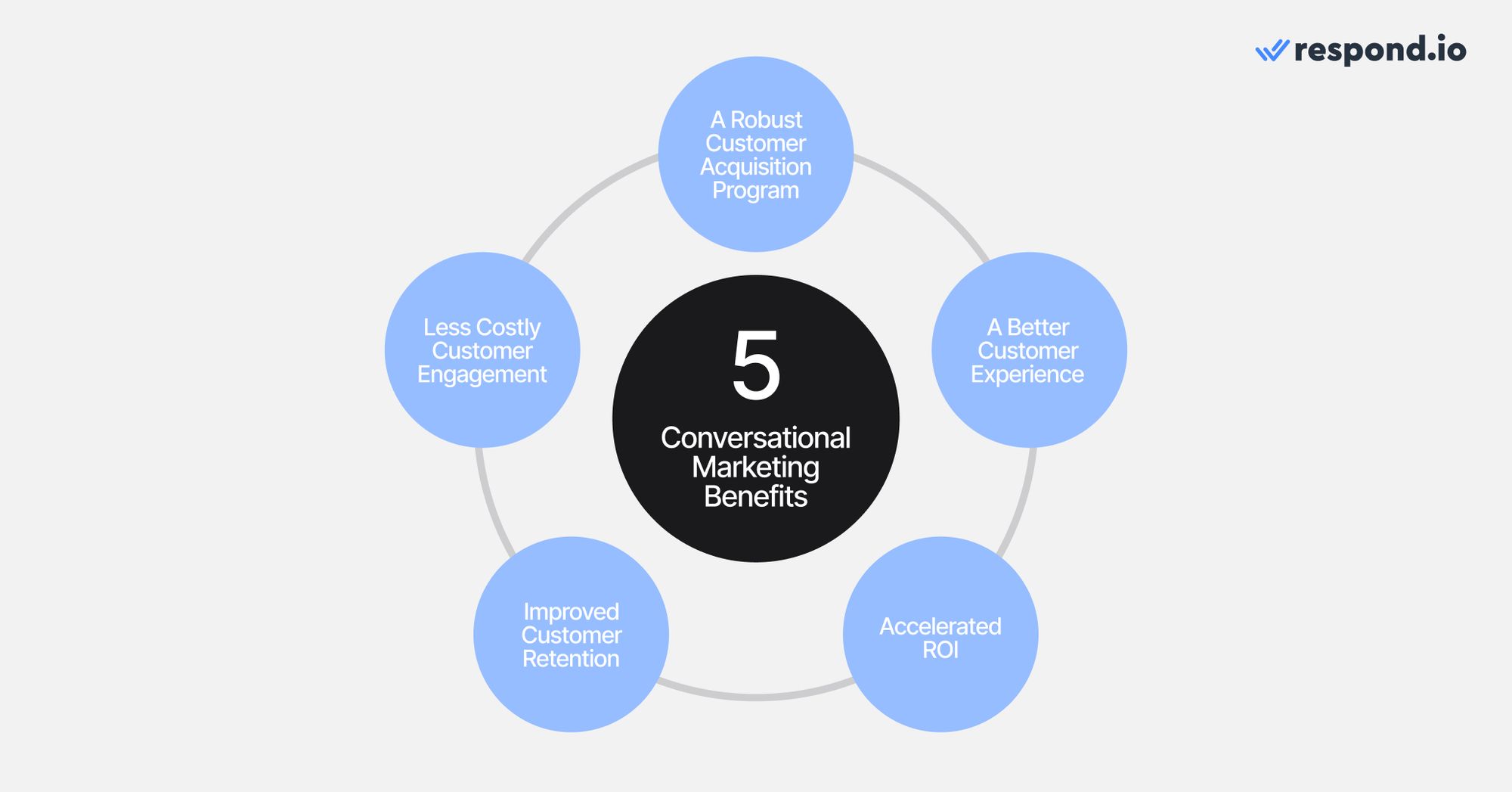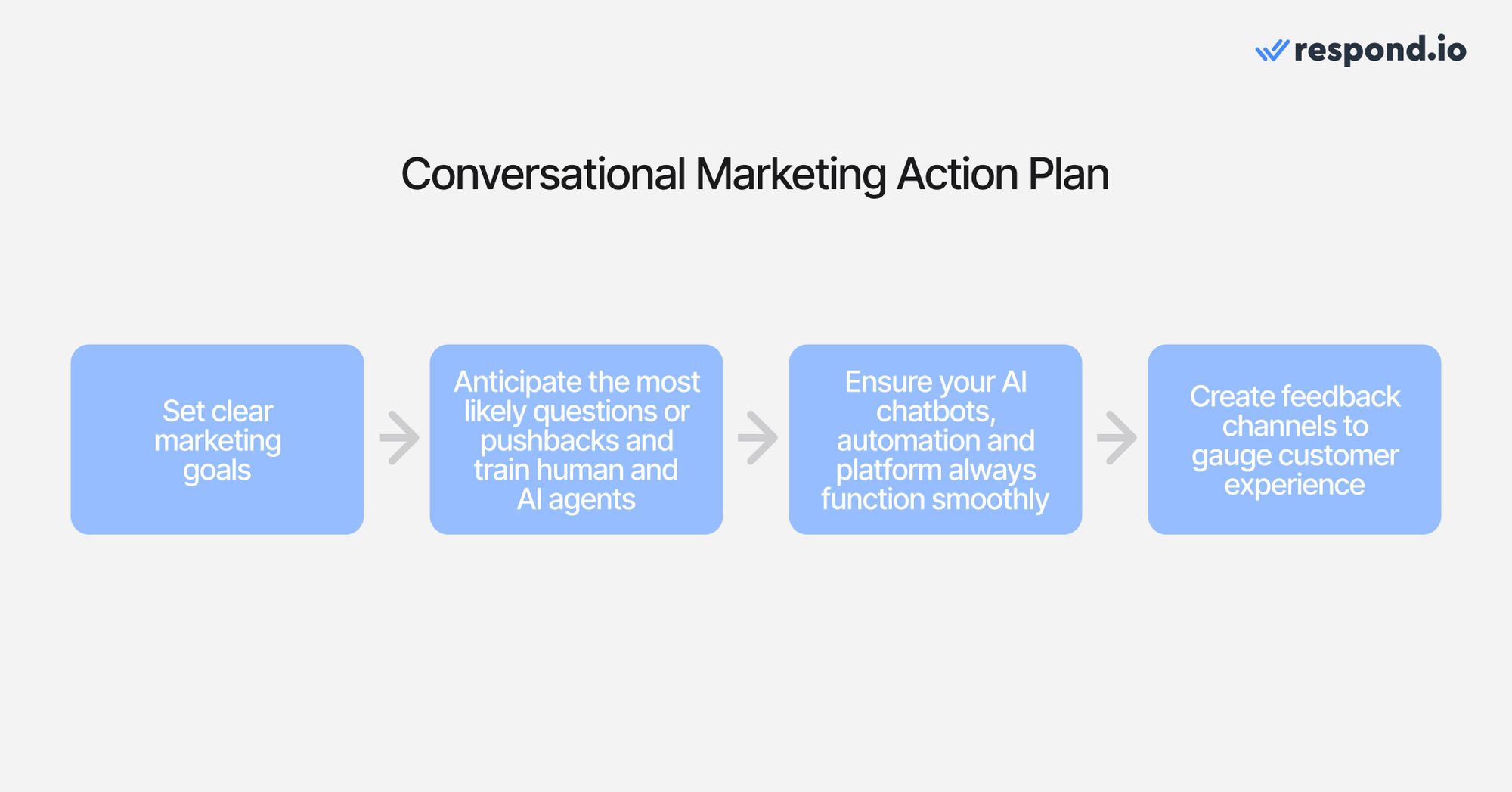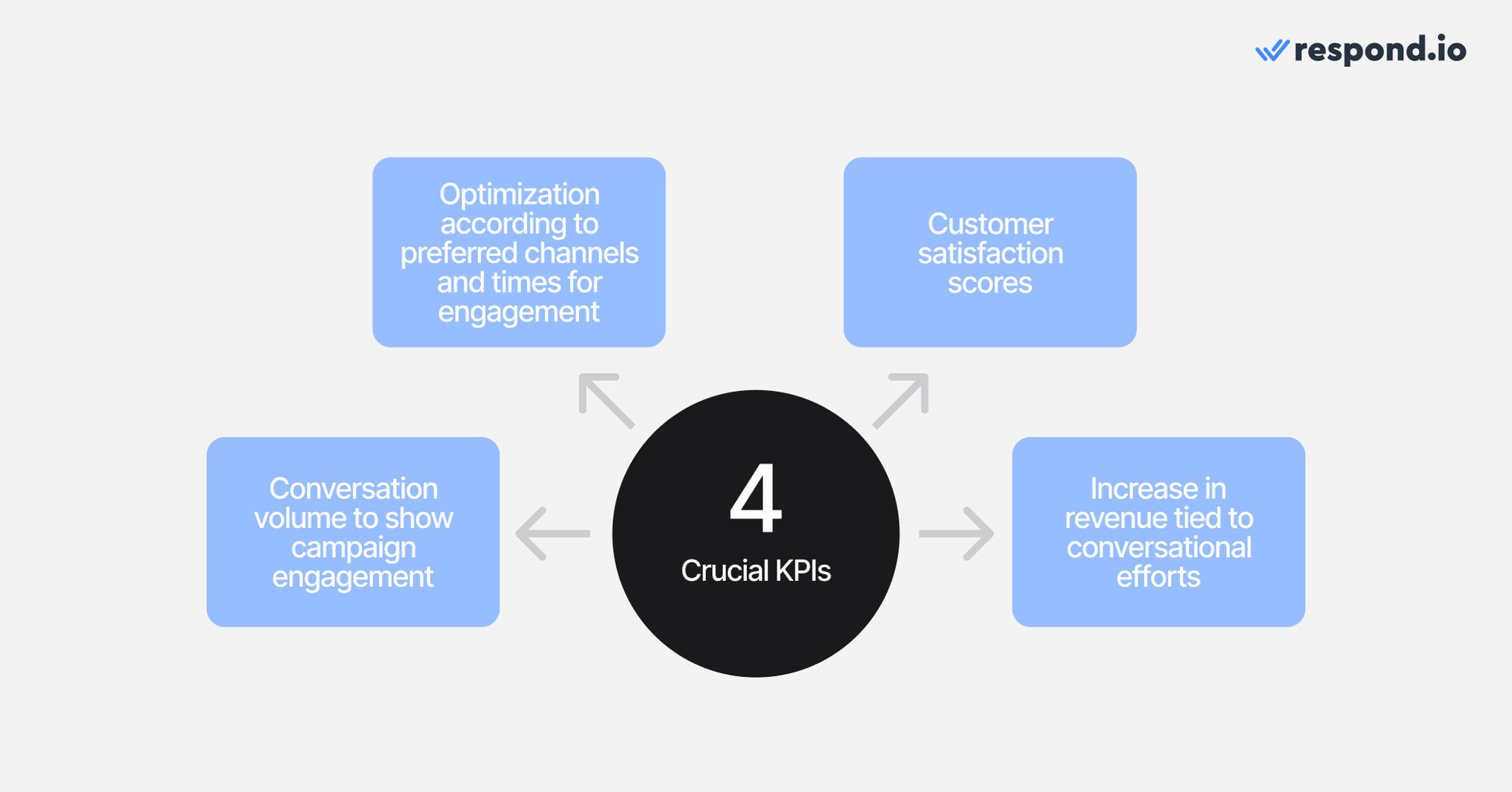
Wondering if conversational marketing is for you? Explore what it is and why it’s crucial for driving revenue in today’s competitive landscape.
We’ll show you how chat-based experiences engage customers and accelerate sales in a way traditional marketing can’t. We also share best practices, potential challenges and actionable strategies for scaling conversations across channels like WhatsApp, Facebook, and web chat.
Finally, we’ll showcase real-world examples of businesses boosting conversions and retention through effective conversational marketing. Ready to generate results over chat? Let’s dive in.
What is Conversational Marketing?
Conversational marketing refers to real-time marketing chats on website widgets, social media and instant messaging channels. It creates revenue-generating opportunities by encouraging leads or customers to ask about your products or services, nurturing them towards first-time or repeat purchases through personalized, one-on-one interactions.
Why is Conversational Marketing Important?
Traditional sales funnels such as lead capture forms, emails and other one-way communication methods are no longer efficient in intensely competitive markets.
For example, customers who receive a marketing email may want to know your delivery charges, or what sizes are in stock. Those who can't get immediate answers frequently become impatient and drop off.
In contrast, we’re seeing significant results from two-way, personalized customer experiences. Customers feel their specific needs are being addressed, which increases buyer confidence. Chat over instant messaging or social apps is a huge part of this strategy. Consider the following statistics:
55% vote for messaging apps as the best way to interact with the brand.
72% expect businesses to respond within 5 minutes of making contact.
70% (of millennials) prefer a company that uses chat instead of email.

A smooth customer experience repeated over time positively influences satisfaction and retention. This is great news for you because:
Replacing lost brand-loyal customers can cost five to seven times more than retaining them
A consistent brand experience builds trust, making customers 88% more likely to buy from you again
A staggering 62% of loyal customers rely exclusively on their trusted brands and are 3.8x more likely to spend more on them
In short, great conversational marketing can create a robust pipeline of leads and returning customers, and accelerate returns on investment (ROI).
How Does Conversational Marketing Work, Especially for Medium to Large Businesses?
Customers respond to a marketing campaign by reaching out to you via touch points such as your website, social media or messaging channels like WhatsApp. Alternatively, prompt engagement on your website with a pop-up asking, "Hello, how can I help you?"
They then enter a real-time chat with you. The back-and-forth nature of the conversation ensures customers are instantly getting the information they need to make a decision, encouraging them to move to the next stage of the customer journey.
However, conversational marketing at scale can place a heavy workload on businesses, especially if you can’t handle conversations 24/7 or are present on multiple channels, such as WhatsApp, Facebook, Instagram and web chat. Common ways to relieve the load include:
Leveraging quick replies that accurately answer customer queries, guiding them smoothly from interest to purchase decision
Using chat automation and AI Agents to automate part of or most of the customer journey, from answering common inquiries to handling lead qualification, chat routing and more
Dialogue-driven chatbot technology has become so sophisticated that many customers believe they’re interacting with a human. If interaction gets complicated, an intelligent workflow will allow a live agent to take over the conversation, creating a seamless customer experience.
This efficiency captures leads while their interest is high and reduces friction that could prevent them from moving quickly to the next stage of the journey.
Turn customer conversations into business growth with respond.io. ✨
Manage calls, chats and emails in one place!
3 Conversational Marketing Strategies
Conversational marketing transforms how brands engage with potential customers, but it doesn’t happen by chance. Below are some critical steps for an impactful and results-driven strategy.
1. Maximize Your Lead Generation Pipeline
Your website is your digital storefront, representing a vibrant platform for leads to connect with your brand. Consider using chat widgets on relevant site pages so visitors can easily ask questions and engage with your brand.
Also use chat links and buttons that enter them directly into a chat on their preferred channel, with the added benefit of capturing customer information like their WhatsApp number or Instagram handle.

Customers continuously surf social media, providing fertile ground to capture their attention in their favorite digital environment. Engaging campaigns and click-to-chat ads on social media feeds are a powerful method to direct target audiences into a chat with you. Apart from chat links and buttons, you can direct leads from your Instagram or Facebook Page into a WhatsApp, Messenger or Instagram chat.
Consider offline touch points like physical stores or trade shows by placing QR codes in strategic locations like merchandise displays, brochures or booths. This turns a possible one-off encounter into a prolonged engagement by allowing them to chat with you at their convenience.
2. Maintain a Robust Conversational Marketing Plan
So you’ve got your marketing conversations up and running. To make sure they deliver the desired outcomes, implement a clear plan. Some steps include:
Set clear marketing goals, such as conversation volume per campaign or conversion rates over chat
Anticipate the most likely questions or pushbacks and train your human and AI agents to respond accordingly
Ensure your AI chatbots, automation and platform always function smoothly and don't emerge as pain points themselves
Create feedback channels such as surveys or rating systems to gauge customers’ experience
These are just a few actions that ensure your conversational marketing initiatives are intentional and focused to better meet your goals.

3. Measure Success with the Right KPIs
Testing, analyzing, and fine-tuning your conversational marketing strategies are all part of the game. But to know what's working, you’ll need to rely on key performance indicators (KPIs) that quickly reflect success or areas to improve. Some valuable KPIs include:
Conversation volume to show campaign engagement
Preferred channels and times for engagement to optimize future campaigns
Customer satisfaction scores from feedback collected directly after chats
Results tied to optimized conversational efforts, such as revenue

Challenges and Best Practices in Conversational Marketing
Conversational marketing at scale can present challenges. High chat volumes can overwhelm your team and delay responses, while the inability to integrate new chat tools with your existing CRM software or tech stack may fragment data and reduce performance.
Striking the right balance between automation and human interaction is also crucial. Generic responses that don’t address specific inquiries not only fail to resonate with customers but actively frustrate them.
If you’re looking to generate significant results from conversational marketing, prioritize a solution that supports personalization, such as the ability to:
Identify various customer segments
Differentiate first-time or returning visitors and existing customers
Identify where customers are in their lifecycle to tailor communication
Use first names or other personal identifiers such as location where necessary
For best results, combine automation and the human touch while leveraging customer data for meaningful, personalized interactions that drive engagement and build lasting customer relationships without compromising efficiency.
2 Conversational Marketing Examples and Case Studies
What you’ve read so far might sound abstract or hard to picture. Here are two real-world success stories from our clients to show you what conversational marketing success can look like.
Sport Center Los Naranjos
This wellness center in Caracas struggled to handle over 1,000 inquiries per month from WhatsApp and other channels, causing delayed responses and significant customer frustration. Internal collaboration was also inefficient as it involved manually referencing an external wellness management software (Fitco).
Respond.io upgraded Sport Center Los Naranjos’ WhatsApp account to API for multi-user WhatsApp access and connected all channels, Fitco and Google Sheets to centralize operations. The unified inbox allowed replies, omnichannel enquires and Click-to-Messenger Ad responses easily, with Workflows automation handling most FAQs and routing chats to appropriate agents.
Managers also had unprecedented insights into customer conversations and could identify areas of improvement and track performance. The result? A whopping 75% reduction in response times and 20% increase in conversions.
H&H Skincare
This Indonesian skincare retailer differentiated itself by offering expert consultations 24/7 via WhatsApp, Instagram, and Facebook and a 24-hour live stream on TikTok. However, escalating chat traffic created severe bottlenecks and although the business upgraded to WhatsApp API, it still couldn’t create its ideal customer experience.
It connected all messaging channels to respond.io, unifying customers’ chat histories across channels to create comprehensive profiles that included data on skin types and problems. H&H Skincare then scaled its customer team and implemented automation across its sales process, from answering FAQs and sending surveys to booking appointments and making purchases.
Personalized responses based on past behavior and broadcasts to finely targeted audiences also kept existing customers re-engaged. As a result, the retailer saw a 60% boost in customer retention and 160% more sales.
Ensure Great Conversational Marketing Results
As you can see, conversational marketing success can only happen by design. It requires clear goals, a focused and actionable strategy, and a comprehensive reporting structure for tracking and optimization.
If you’re doing this at scale, whether you have multiple colleagues or teams, are present on multiple channels or handle a massive customer base, your chosen software should not only support these initiatives but make it easy for you to achieve success.
This includes features such as multichannel support, customer profiles and lifecycle management for tailored communication, integrations with your existing tech stack, and automation or AI that reduces repetitive work and can transfer complex queries or VIP customers seamlessly to human agents.
Respond.io does all this and more, with comprehensive reports and analytics—including Paid Ads attribution to track which campaigns drive real conversions—and a record 99.999% platform uptime, allowing you to deliver consistently great customer experiences that foster trust and loyalty.
Curious how your business can benefit from a solution like this? Sign up for a free trial or book a customized demo today to start tapping into the huge ROI potential of conversational marketing.
Turn customer conversations into business growth with respond.io. ✨
Manage calls, chats and emails in one place!
Further Reading
Interested in learning more about boosting your business through conversations? Check out these articles.






































 Electronics
Electronics Fashion & Apparel
Fashion & Apparel Furniture
Furniture Jewelry and Watches
Jewelry and Watches
 Afterschool Activities
Afterschool Activities Sport & Fitness
Sport & Fitness
 Beauty Center
Beauty Center Dental Clinic
Dental Clinic Medical Clinic
Medical Clinic
 Home Cleaning & Maid Services
Home Cleaning & Maid Services Photography & Videography
Photography & Videography
 Car Dealership
Car Dealership
 Travel Agency & Tour Operator
Travel Agency & Tour Operator




